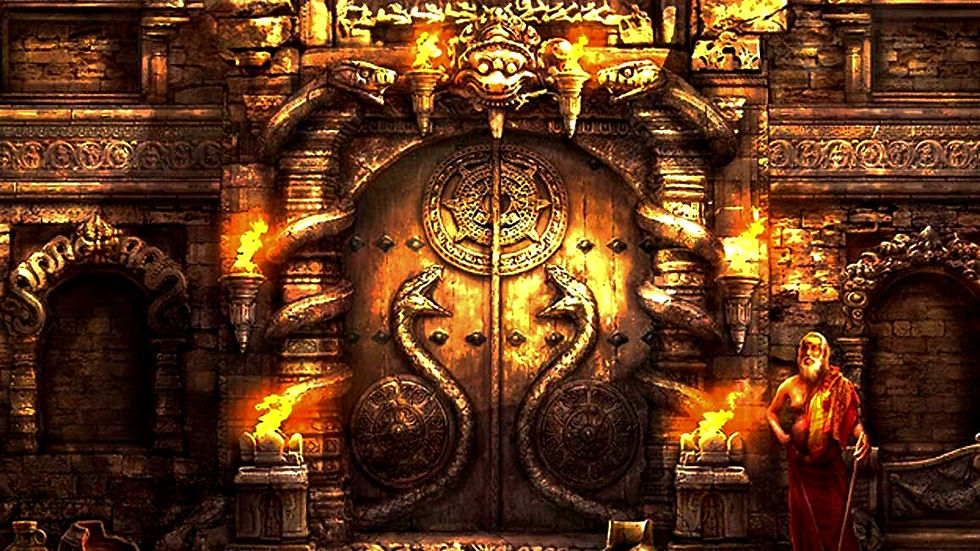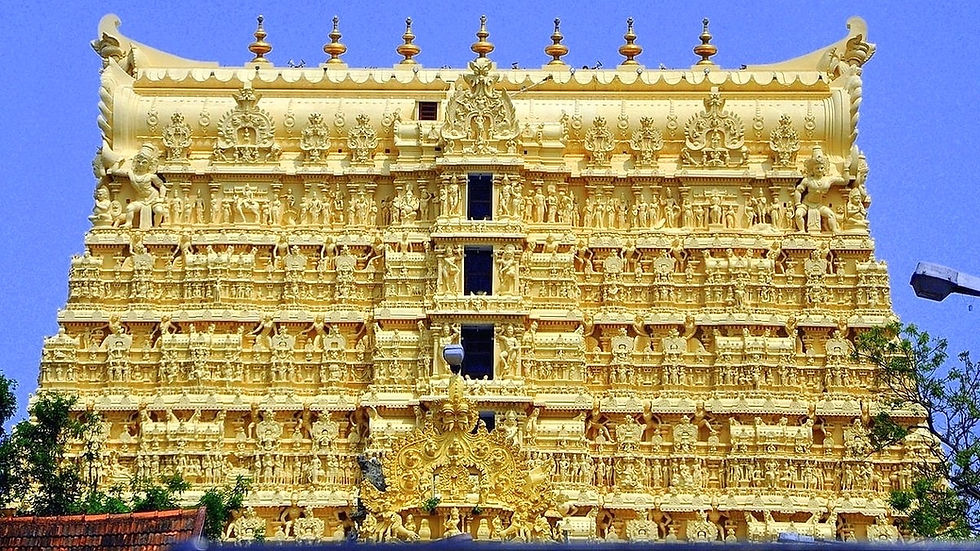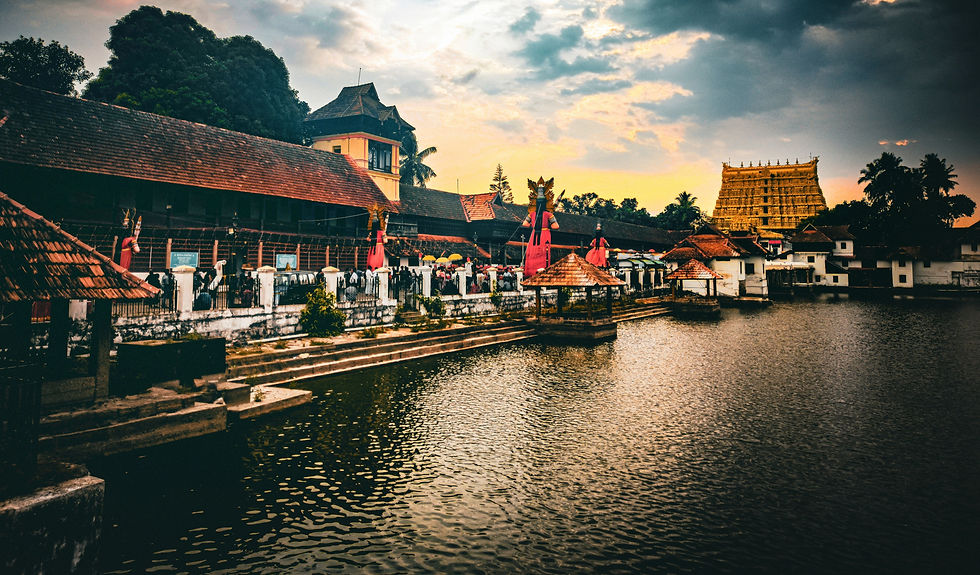Sree Padmanabhaswamy Temple, Thiruvananthapuram
- Samarth Bugade

- Jun 22, 2023
- 6 min read
Unveiling the Sacred Secrets- Where art blends with Science

Welcome to a captivating journey through the revered Sree Padmanabhaswamy Temple, a place shrouded in divinity and mystery. Located in Thiruvananthapuram, Kerala, this ancient Hindu temple is known for its exquisite architecture, religious significance, and its association with the world's richest temple treasure. Let's embark on an exploration of this sacred abode.
Location:
Sree Padmanabhaswamy Temple is located in Thiruvananthapuram, the capital city of Kerala, in the southern part of India. Thiruvananthapuram is nestled along the coast of the Arabian Sea and offers a serene backdrop of beaches and lush greenery.
Deity and Significance:
The presiding deity of the temple is Lord Padmanabhaswamy, an incarnation of Lord Vishnu, reclining on the divine serpent Ananta. Lord Padmanabhaswamy is revered as the protector and sustainer of the universe. The temple holds immense spiritual significance for Vaishnavites and is one of the 108 Divya Desams, sacred abodes of Lord Vishnu.
Architectural Marvel:
The temple's architecture is a splendid blend of Dravidian and Kerala styles. The towering gopuram (gateway) adorned with intricate carvings greets visitors at the entrance. The temple complex boasts a fusion of wood and stone carvings, mural paintings, and exquisite sculptures that depict scenes from Hindu mythology.
The Secret Vault:
One of the intriguing aspects of the Sree Padmanabhaswamy Temple is its secret vaults. In 2011, these vaults gained international attention when they were discovered to house an astounding amount of treasure, making it the richest temple in the world. The treasure includes precious stones, gold ornaments, antique jewelry, and other invaluable artifacts.
Rituals and Festivals:
The temple follows strict rituals and traditions. Daily pujas (ritualistic worship) and darshan (viewing of the deity) are conducted with utmost devotion. The temple comes alive during festivals like the Alpashy festival, Navaratri, and the famous Laksha Deepam, where thousands of oil lamps illuminate the temple premises.
Historical Significance:
The origins of the temple can be traced back to ancient times. It has witnessed the rise and fall of various dynasties, including the Cheras, Cholas, and the Travancore Royal Family. The temple was patronized by the Travancore kings, who played a significant role in its development and preservation.
Temple Treasure:
The temple's wealth has been a subject of fascination and intrigue. The treasures found in the vaults are believed to be accumulated over centuries, with some items dating back several millennia. The treasure remains under the administration of the Travancore Royal Family, and its value is estimated to be worth billions of dollars.
Mystery of Sree Padmanabhaswamy Temple
The Secret Vaults:

° The sacred and simple-looking temple has underground chambers, deep inside the surface which have treasures in them.
° There are in total six vaults in the temple which were totally secured and were taken care of by the royal Travancore family.
° The treasure in the vaults is being accumulated for thousands of years literally and dates back to 200 B.C.
° The six vaults of the temple are named the alphabetical letters from A to F. Vault C to F had been opened earlier and a tremendous amount of treasure was found in them.
° It was said that vaults A and F cannot be opened since they have a curse laid on them but later, the Supreme Court gave orders in 2011 to open vault A.
° The total value accounted for all the treasure found till the present time is around, which is
1 Lac crores INR more than the wealth of the Mughals, Nizam of Hyderabad, and the British crown jewels all combined together.

The vault B was also opened but there was a snake door to it that had no joints or bolts. Priests have given warnings not to open it as it can cause serious troubles to the people of Kerala and the caretaker’s family as the vault is cursed.
It is estimated that if Vault B gets opened, the total estimated amount of treasure would be around $1 trillion.
The treasure found until now contains gold chairs, pots, jars, crowns, and a large thrown completely made of gold and studded with hundreds of diamonds and precious gems. There are bundles of gold coins weighing 800 kilos approximately, and each coin has an estimated value of 2.5 crores at least. There is a gold chain that is 8 feet long and coins from the era of Napoleon and the Romans. The treasure does not end here, it has around 1200 chains of gold and precious stones, sacks full of ancient artifacts, gems, necklaces, coconut shells, a gold sheaf of 500 kilos, and a gold idol of Mahavishnu studded with diamonds with a height of 3 and a half feet.

The Mysterious Unopened Vault B
This vault is considered to be more dear to Ananta Padmanabaswamy and it is said the world will be destroyed when the door is opened.
This temple is considered to be protected by serpents and Guardian angels and the door can be only opened when a well-learned scholar recites Garuda Mantra.
When the committee tried to open the door they heard the sound of waves from behind the door and stopped the work.
Some theory suggests that the Arabian Sea is on the other side of the door, some Sudharsana Chakra, some way to nag lok, etc…
In a real incident when a gang of robbers tried to open the door, they got chased by serpents emerging from the door.

The architectural marvel of Gopuram
The phenomenon occurs twice a year and during this time, when the Sun sets, it aligns perfectly with the windows of the Gopuram. As time passes, it feels as if the Sun is coming down, step by step, peeping through each window.
This feature required the construction of the Gopuram to be exactly on the East-West line, not deviating even a single degree on either side. This is definitely an Engineering Marvel. On days past the equinox, the setting Sun gets blocked by the tower structure. Hence, if one has to witness this phenomenon, they have to be at this place either during the autumn or spring equinox.
Equinox: When the earth’s axis is at a 0° tilt and hence the day and night duration is equal.
The autumn equinox occurs on the 22nd or 23rd of September while the spring equinox occurs either on the 20th or 21st of March.

The most distinctive feature of the temple, the 100 ft high gopuram (sanctum sanctorum), stands at the eastern entrance. The gopuram is a clear influence of the Dravidian architecture, which is quite prevalent in the southern part of India. The pyramidal tower is made of granite and brick with a foundation that goes 40 feet below the ground. Ornate sculptures adorn the walls of this lofty edifice, depicting gods, goddesses, and life as per Sanathan Dharm.
The seven-story Gopuram with various carvings and statues. The windows are all aligned in the middle in one straight line. Top of the gopuram with golden Kalasha on top, carvings of Vishnu in various incarnations in the first layer.
There are seven floors to this gopuram, with a pair of window-like openings along the center on opposite sides of six of these floors. The opening on the lowest floor is also the doorway to the temple. On top of the edifice, seven golden kalasha are placed evenly spaced, pointing to the sky. The ten different incarnations of Lord Vishnu are portrayed inside the top story of the gopuram.

Sreebalipurra:
It is a long rectangular corridor, supported by 365 pillars, which looks very similar to the pillared hallway of the Ramnathaswamy temple of Rameswaram. The stone pillars represent the 365 days of a year and bear intricate mythical carvings on them, that enhance the already mesmerizing hallway's many folds.
While walking down the hallway residue of burning diyas on a particular place on all the pillars. Imagine the beauty of the hallway with all its pillars lit, during special ceremonies.
Padmatheertham Pond

Ananthapuravarnanam, a 13th-century composition by an unknown poet mentions Ananthatheertham (old name of Padmatheertham) along with other tanks surrounding the Sree Padmanabhaswamy temple. Local historians such as V. Narasimhan Thampi maintain that the pond was enlarged in the 14th century, during the reign of Veera Rama Marthanda Varma, who used the earth from the excavations to construct a rampart around Sree Padmanabhaswamy temple. The tank transformed into its present state in the 18th century, after renovations carried out by Anizham Thirunal Marthanda Varma and Dharmaraja. Padmatheertham was supplied with a fresh supply of water from the Killi River by means of a rivulet by the name Kochar. Subsequent rulers took necessary measures to maintain the temple tank. In 1813, oil lamps were installed on the banks of Padmatheertham. A system of periodic maintenance was also introduced to clean the pond in association with the Murajapam festival.

If we walk across the sanctum, peeping through each of the three doors to complete the darshan of the lord. The first door provides the view of the face, the 5 heads of the serpent Adishesha, and the right hand, covered with a golden gauntlet resting on a Shiva Linga. The idol is massive, and the first door does a great job of introducing the Lord and wowing all visitors with its grandness.
The second door introduces us to the torso of the Lord with the lotus emerging from the Naval, which also has lord Brahma sitting on it. It's worth noting that the name Padmanabhaswamy is reflective of this lotus that emanates from the naval.
The third and last door provides a view of the feet of the Lord, with the massive gold dhoti covering the entire leg, except the feet. The toes are also covered with gold ornaments, which just gleam in the orange hue of the light of the massive earthen lamps.
This marked the end of the darshan, The dark interiors, the beautifully crafted idol, and the use of gold, this is the marvelous craft of the god.




Comments